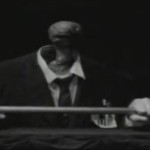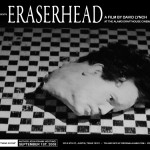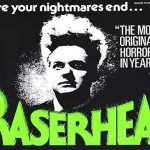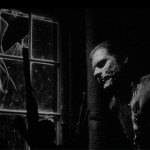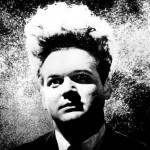In a recent blog listing a selection of seriously scary movies, I said this about David Lynch‘s debut movie:
Eraserhead – when I first saw Eraserhead in Nottingham, I had absolutely no idea what it was about, nor had I heard of Lynch. This is a classic exercise in weirdness that is so surrealistic you really have little idea what is going on – but that shock tactic is why I remembered it so vividly.
Trying to describe the movie in greater detail is quite difficult. If this description of the plot sounds odd, that’s because it is – but here goes (courtesy of Wikipedia):
The Man in the Planet (Jack Fisk) is seen moving levers in his home in space, while the head of Henry Spencer (Jack Nance) is seen floating in the sky. A spermatozoon-like creature emerges from Spencer’s mouth, floating into the void.
In an industrial cityscape, Spencer walks home with his groceries. He is stopped outside his apartment by the Beautiful Girl Across the Hall (Judith Anna Roberts), who informs him that his girlfriend, Mary X (Charlotte Stewart), has invited him to dinner with her family. Spencer leaves his groceries in his apartment, which is filled with piles of dirt and dead vegetation. That night, Spencer visits X’s home, conversing awkwardly with her mother (Jeanne Bates). At the dinner table, he is asked to carve a chicken that X’s talkative father (Allen Joseph) has “made”; the bird moves and writhes on the plate and gushes blood. After dinner, Spencer is cornered by X’s mother, who tries to kiss him. She tells him that X has had his child and that the two must marry. X, however, is not sure if what she bore is a child.
The couple move into Spencer’s one-room apartment and begin caring for the child—a swaddled bundle with an inhuman, snakelike face, resembling the spermatozoon creature seen earlier. The infant refuses all food, crying incessantly and intolerably. The sound drives X hysterical, and she leaves Spencer and the child. Spencer attempts to care for the child, and he learns that it struggles to breathe and has developed painful sores.
Spencer begins experiencing visions, again seeing the Man in the Planet, as well as the Lady in the Radiator (Laurel Near), who sings to him as she stomps upon miniature replicas of Spencer’s child. After a sexual encounter with the Beautiful Girl Across the Hall, Spencer has another vision, seeing his own head fall off, revealing a stump underneath that resembles the child’s face. Spencer’s head falls from the sky, landing on a street and breaking open. A boy finds it, bringing it to a pencil factory to be turned into erasers. Spencer is then seen, in his normal form, in a billowing cloud of eraser shavings.
Spencer tries to seek out the Beautiful Girl Across the Hall, but she has begun taking other men home. Crushed, Spencer returns to his room, where the child is crying. He takes a pair of scissors and for the first time removes the child’s swaddling. It is revealed that the child has no skin; the bandages held its internal organs together, and they spill apart after the rags are cut. The child gasps in pain, and Spencer stabs its organs with the scissors. The wounds gush a thick liquid, covering the child. The power in the room overloads, causing the lights to flicker; as they flick on and off the child grows to huge proportions. As the lights burn out completely, the child’s head is replaced by the planet seen at the beginning. The side of the planet bursts apart, and inside, the Man in the Planet struggles with his levers, which are now emitting sparks. Spencer is embraced warmly by the Lady in the Radiator, as both white light and white noise build to a crescendo before the screen turns black and silent.
But then this is a movie in a dream-like state where there may or may not be symbolic significance, such that the context behind the movie may make more sense than the events portrayed:
Writer and director David Lynch had previously studied for a career as an artist, and he had created several short films to animate his paintings. By 1970, however, he had switched his focus to film-making, and at the age of 24 he accepted a scholarship at the American Film Institute‘s Centre for Advanced Film Studies. Lynch disliked the course and considered dropping out, but he changed his mind after he was offered the chance to produce a script of his own devising. He was given permission to use the school’s full campus for film sets; he converted the school’s disused stables into a series of sets and lived there. In addition, Greystone Mansion, also owned by the AFI, was used for many scenes.
Lynch had initially begun work on a script titled Gardenback, based on his painting of a hunched figure with vegetation growing from its back. Gardenback was a surrealist script about adultery, which featured a continually growing insect representing one man’s lust for his neighbor. The script would have resulted in a roughly 45-minute-long film, which the AFI felt was too long for such a figurative, nonlinear script. In its place, Lynch presented Eraserhead, which he had developed based on a daydream of a man’s head being taken to a pencil factory by a small boy. Several board members at the AFI were still opposed to producing such a surrealist work, but they were persuaded when dean Frank Daniel threatened to resign if it was vetoed.[7] Lynch’s script for Eraserhead was influenced by his reading as a film student; Franz Kafka‘s 1915 novella The Metamorphosis and Nikolai Gogol‘s 1836 short story “The Nose” were strong influences on the screenplay.
The script is also thought to have been inspired by Lynch’s fear of fatherhood; his daughter Jennifer had been born with “severely clubbed feet“, requiring extensive corrective surgery as a child. Jennifer has claimed that her own unexpected conception and birth defects were the basis for the film’s themes. The tone of the film was also shaped by Lynch’s time living in a troubled neighborhood inPhiladelphia. Lynch and his family spent five years living in an atmosphere of “violence, hate and filth”.The area was rife with crime, inspiring the bleak urban backdrop of Eraserhead. Describing this period of his life, Lynch said “I saw so many things in Philadelphia I couldn’t believe … I saw a grown woman grab her breasts and speak like a baby, complaining her nipples hurt. This kind of thing will set you back”. Film critic Greg Olson, in his book David Lynch: Beautiful Dark, posits that this time contrasted starkly with the director’s childhood in the Pacific Northwest, giving the director a “bipolar, Heaven-and-Hell vision of America” which has subsequently shaped his films.
Initial casting for the film began in 1971, and Jack Nance was quickly selected for the lead role. However, the staff at the AFI had underestimated the project’s scale—they had initially green-litEraserhead after viewing a twenty-one page screenplay, assuming that the film industry’s usual ratio of one minute of film per scripted page would reduce the film to approximately twenty minutes. This misunderstanding, coupled with Lynch’s own meticulous direction, caused the film to remain in production for a number of years. In an extreme example of this labored schedule, one scene in the film begins with Nance’s character opening a door—a full year would pass before he was filmed entering the room. Nance, however, was dedicated to producing the film and retained the unorthodox hairstyle his character sported for the entirety of its gestation.
In short, this is a movie unsettling because you cannot in your conscious mind apply rational concepts of meaning, but within your unconscious mind there may be many very uncomfortable associations taking you back to childhood insecurities and beyond; it will provoke thoughts you would rather not be provoked. Yes, it hits the parts other films don’t go remotely near.
This is Freudian cinema at its sharpest and almost certainly the strangest. Cult classic? Many will hate it but everyone will come away deeply unsettled by what they have seen.


